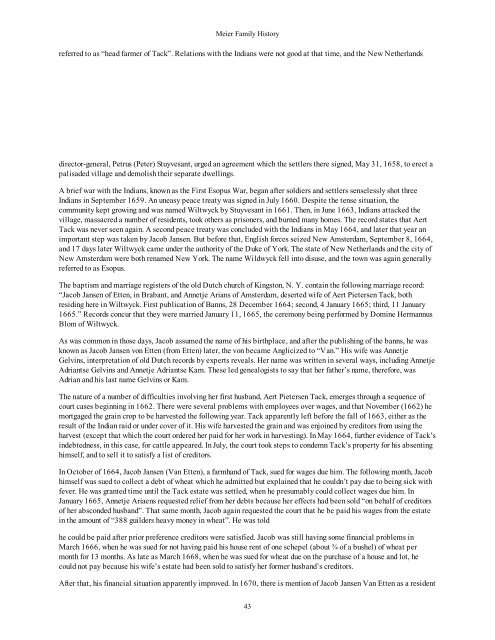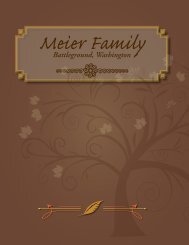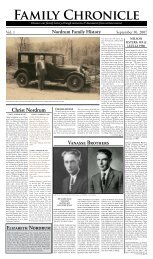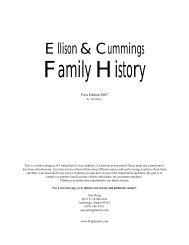Meier & Matson Family History
Meier & Matson Family History
Meier & Matson Family History
Create successful ePaper yourself
Turn your PDF publications into a flip-book with our unique Google optimized e-Paper software.
<strong>Meier</strong> <strong>Family</strong> <strong>History</strong><br />
referred to as “head farmer of Tack”. Relations with the Indians were not good at that time, and the New Netherlands<br />
director-general, Petrus (Peter) Stuyvesant, urged an agreement which the settlers there signed, May 31, 1658, to erect a<br />
palisaded village and demolish their separate dwellings.<br />
A brief war with the Indians, known as the First Esopus War, began after soldiers and settlers senselessly shot three<br />
Indians in September 1659. An uneasy peace treaty was signed in July 1660. Despite the tense situation, the<br />
community kept growing and was named Wiltwyck by Stuyvesant in 1661. Then, in June 1663, Indians attacked the<br />
village, massacred a number of residents, took others as prisoners, and burned many homes. The record states that Aert<br />
Tack was never seen again. A second peace treaty was concluded with the Indians in May 1664, and later that year an<br />
important step was taken by Jacob Jansen. But before that, English forces seized New Amsterdam, September 8, 1664,<br />
and 17 days later Wiltwyck came under the authority of the Duke of York. The state of New Netherlands and the city of<br />
New Amsterdam were both renamed New York. The name Wildwyck fell into disuse, and the town was again generally<br />
referred to as Esopus.<br />
The baptism and marriage registers of the old Dutch church of Kingston, N. Y. contain the following marriage record:<br />
“Jacob Jansen of Etten, in Brabant, and Annetje Arians of Amsterdam, deserted wife of Aert Pietersen Tack, both<br />
residing here in Wiltwyck. First publication of Banns, 28 December 1664; second, 4 January 1665; third, 11 January<br />
1665.” Records concur that they were married January 11, 1665, the ceremony being performed by Domine Hermannus<br />
Blom of Wiltwyck.<br />
As was common in those days, Jacob assumed the name of his birthplace, and after the publishing of the banns, he was<br />
known as Jacob Jansen von Etten (from Etten) later, the von became Anglicized to “Van.” His wife was Annetje<br />
Gelvins, interpretation of old Dutch records by experts reveals. Her name was written in several ways, including Annetje<br />
Adriantse Gelvins and Annetje Adriantse Kam. These led genealogists to say that her father’s name, therefore, was<br />
Adrian and his last name Gelvins or Kam.<br />
The nature of a number of difficulties involving her first husband, Aert Pietersen Tack, emerges through a sequence of<br />
court cases beginning in 1662. There were several problems with employees over wages, and that November (1662) he<br />
mortgaged the grain crop to be harvested the following year. Tack apparently left before the fall of 1663, either as the<br />
result of the Indian raid or under cover of it. His wife harvested the grain and was enjoined by creditors from using the<br />
harvest (except that which the court ordered her paid for her work in harvesting). In May 1664, further evidence of Tack’s<br />
indebtedness, in this case, for cattle appeared. In July, the court took steps to condemn Tack’s property for his absenting<br />
himself, and to sell it to satisfy a list of creditors.<br />
In October of 1664, Jacob Jansen (Van Etten), a farmhand of Tack, sued for wages due him. The following month, Jacob<br />
himself was sued to collect a debt of wheat which he admitted but explained that he couldn’t pay due to being sick with<br />
fever. He was granted time until the Tack estate was settled, when he presumably could collect wages due him. In<br />
January 1665, Annetje Ariaens requested relief from her debts because her effects had been sold “on behalf of creditors<br />
of her absconded husband”. That same month, Jacob again requested the court that he be paid his wages from the estate<br />
in the amount of “388 guilders heavy money in wheat”. He was told<br />
he could be paid after prior preference creditors were satisfied. Jacob was still having some financial problems in<br />
March 1666, when he was sued for not having paid his house rent of one schepel (about ¾ of a bushel) of wheat per<br />
month for 13 months. As late as March 1668, when he was sued for wheat due on the purchase of a house and lot, he<br />
could not pay because his wife’s estate had been sold to satisfy her former husband’s creditors.<br />
After that, his financial situation apparently improved. In 1670, there is mention of Jacob Jansen Van Etten as a resident<br />
43









